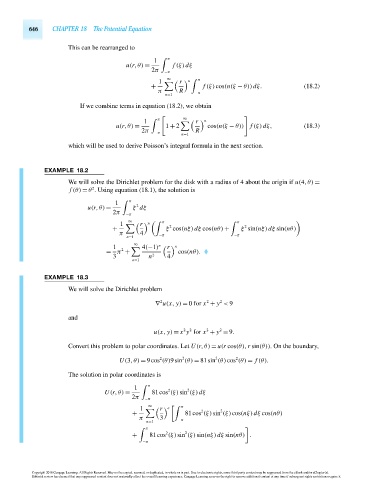Page 666 - Advanced_Engineering_Mathematics o'neil
P. 666
646 CHAPTER 18 The Potential Equation
This can be rearranged to
1 π
u(r,θ) = f (ξ)dξ
2π −π
1 r π
∞ n
+ f (ξ)cos(n(ξ − θ))dξ. (18.2)
π R
n=1 −π
If we combine terms in equation (18.2), we obtain
1 π r
∞ n
u(r,θ) = 1 + 2 cos(n(ξ − θ)) f (ξ)dξ, (18.3)
2π −π R
n=1
which will be used to derive Poisson’s integral formula in the next section.
EXAMPLE 18.2
We will solve the Dirichlet problem for the disk with a radius of 4 about the origin if u(4,θ) =
2
f (θ) = θ . Using equation (18.1), the solution is
1 π
2
u(r,θ) = ξ dξ
2π −π
1 r π π
∞ n
2
2
+ ξ cos(nξ)dξ cos(nθ) + ξ sin(nξ)dξ sin(nθ)
π 4
n=1 −π −π
∞
1 4(−1) n n
r
2
= π + cos(nθ).
3 n 2 4
n=1
EXAMPLE 18.3
We will solve the Dirichlet problem
2
2
2
∇ u(x, y) = 0for x + y < 9
and
2
2
2
2
u(x, y) = x y for x + y = 9.
Convert this problem to polar coordinates. Let U(r,θ) = u(r cos(θ),r sin(θ)). On the boundary,
2
2
2
2
U(3,θ) = 9cos (θ)9sin (θ) = 81sin (θ)cos (θ) = f (θ).
The solution in polar coordinates is
1 π 2 2
U(r,θ) = 81cos (ξ)sin (ξ)dξ
2π −π
1 r π 2 2
∞ n
+ 81cos (ξ)sin (ξ)cos(nξ)dξ cos(nθ)
π 3 −π
n=1
π
2
2
+ 81cos (ξ)sin (ξ)sin(nξ)dξ sin(nθ) .
−π
Copyright 2010 Cengage Learning. All Rights Reserved. May not be copied, scanned, or duplicated, in whole or in part. Due to electronic rights, some third party content may be suppressed from the eBook and/or eChapter(s).
Editorial review has deemed that any suppressed content does not materially affect the overall learning experience. Cengage Learning reserves the right to remove additional content at any time if subsequent rights restrictions require it.
October 14, 2010 15:27 THM/NEIL Page-646 27410_18_ch18_p641-666

